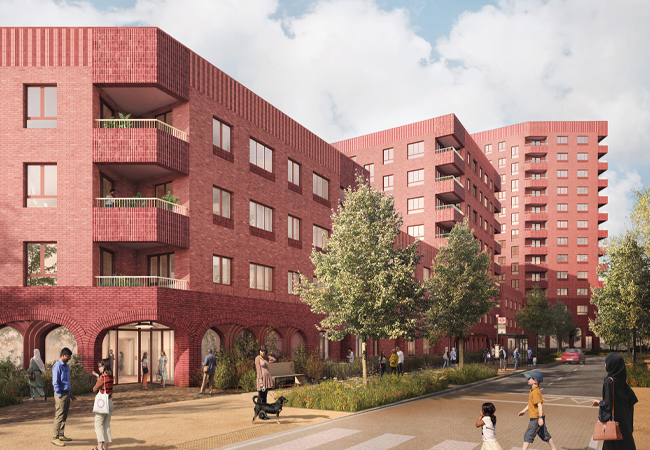
The scheme’s embodied carbon is expected to be reduced with each phase of delivery
When the London Borough of Hounslow set about redeveloping the Convent Way estate, it decided to demolish the existing 1960s buildings, with their chronic repair issues. It would replace them with a scheme that will set a new urban dwelling standard for the borough and help residents address fuel poverty.
Bell Phillips Architects developed a masterplan for the estate, based on the delivery of 967 new Passivhaus homes, mostly apartments. The plan is to deliver it over five phases, to allow the current residents to be rehoused progressively without having to leave the estate.
Because the scheme is aligned with the RIBA 2030 climate challenge, embodied carbon is expected to be reduced with each phase of delivery.
The concept was for the 117 homes being built under Phase A to be all-electric, and for the homes’ parking spaces to incorporate electric vehicle charge points. To deliver this sustainable scheme, the architect appointed QODA Consulting as MEP and sustainability engineers.
Together they set about designing the first phase of the scheme to RIBA Stage 3, to enable it to be tendered. ‘The full design and construction of Phase A will provide the template for the remaining phases,’ says Henry Metcalfe, senior electrical engineer at QODA Consulting.
Constrained grid
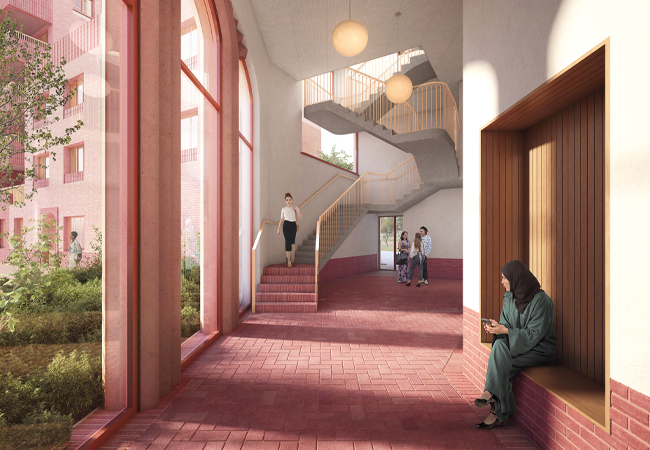
The buildings are designed to maximise solar gain in winter and minimise it in summer
Realisation of the all-electric concept, however, was far from straightforward in this area of West London, where there are already huge stresses on the electricity Grid. The district network operator (DNO) for the area is Scottish and Southern Electricity Networks (SSEN), which capped the additional load that the scheme could impose on its electricity infrastructure at 1MVA per year.
‘As long as we phase the development and keep the additional electrical demand below 1MVA per year, SSEN says it can be accommodated,’ says Metcalfe. The challenge for QODA was to develop an all-electric building services solution to comply with this requirement.
The scheme’s heating was always going to have to be all-electric, adds Metcalfe, because there are no adjacent heat networks for the scheme to tap into. Using the BSRIA Rule of Thumb from 2011 gives a load of 7.5kW per apartment for high-specification flats with electric cooking and heating. Even with the coincident diversity factor that BSRIA says may be applied for apartment blocks, Metcalfe says the figure is still extremely high and ‘obviously outdated’ – so QODA set about developing a more accurate estimate for the apartments.
The fabric-first approach enshrined in Passivhaus principles helped keep heating loads low. The proposal has been modelled on a 2050 weather file to future-proof the design. ‘We did a lot of work with the architect to create the most efficient building form that would maximise solar gain in winter and minimise overheating in summer,’ explains Metcalfe.
Initially, direct electric heating was considered. Although this would have been easier to install – and probably easier for occupants to use – Metcalfe says it is ‘not as efficient as a heat pump-based solution and has limited load diversity at scale’.
Instead, QODA has opted for what Metcalfe describes as a ‘two-stage’ heat pump solution incorporating an ambient loop’ for the scheme’s first phase. ‘Heat pumps are so much more efficient at scale due to the diversity that can be applied, and they have a better coefficient of performance (COP) than direct electric,’ he adds.
A second-stage heat pump in each apartment will upgrade the ambient loop heating temperature from
20°C to 45°C
The two-pipe ambient loop serves all three apartment blocks being constructed under the initial phase. The large first-stage air source heat pump mounted on the roof of one of the blocks will maintain the loop temperature at around 25°C. ‘That heat pump has a heat load that has been diversified by the mechanical engineer, as recommended in CIBSE CP1, so we simply provide the electrical input to meet that diversified heat demand,’ Metcalfe says.
A second-stage heat pump in each apartment will upgrade the ambient loop temperature from 25°C to 45°C for space heating. Radiators are significantly larger than if they were operating at Delta T of 50°C. However due to the reduced heat losses, they are still modest in size.
The domestic hot water (DHW) is also generated by the second stage heat pump, and stored in an integral cylinder at high temperatures that prevent legionella growth.
Metcalfe says QODA was able to estimate the peak diversified demand for Phase A at 176.4kW. ‘I used the Passivhaus specific heating demand requirement of 15kWh·m2 per year and specific heating load of 10W·m2 into a tool I created in Excel and used the number of each apartment type to work out the total heat load,’ he says.
Using the diversified ambient loop heat demand figure of 176.4kW, Metcalfe applied the heat pump COP to get an estimate for the electrical input. ‘If you then factor in the coefficient of performance of 4.2 for the initial heat pump, that gives an electrical input of 42kW,’ he explains. If you then divide this figure by 117 (the number of apartments) you get a figure of 0.36kW.
‘You can then add this figure to the 4kW electrical input for the apartment heat pump, which is fitted with an integral pump to allow for pumping power, you get an approximate total electrical input per apartment of 4.36kW for heating plus small power and lighting loads,’ adds Metcalfe.
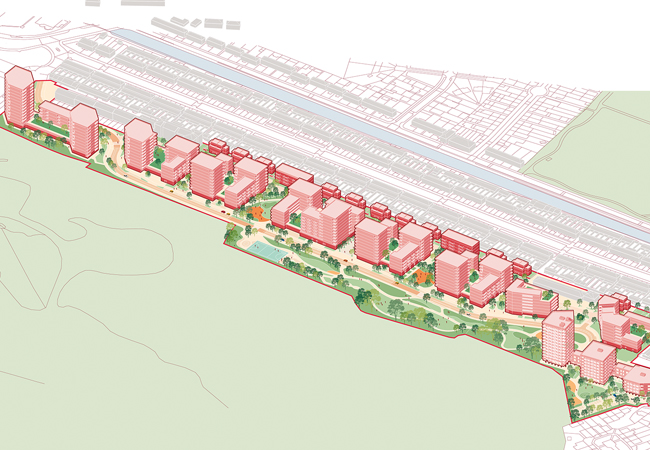
Built in five phases, the new estate will eventually have 967 Passivhaus homes, mostly apartments
Apartment heat pumps have been designed to run in cooling mode in summer to provide tempered air via an MVHR. In the cooling season, the heat pump will temper the air via a cooling coil in the supply air ductwork.
Heat removed from the apartments is rejected into the ambient loop so other apartments can use the heat to reduce the need to run the main heat pump.
One major issue thrown up by the project is electrical harmonics generated by the heat pumps. ‘We’ve been talking to a major heat pump manufacturer,’ says Metcalfe. ‘The data they provide are rated power, full load current, starting current, and nominal running current; what they don’t give you is any kind of harmonic information on waveform distortion.’
Electrical systems can tolerate some harmonic content, but when harmonics are excessive, problems can arise, including overheating of the distribution cables and circuit breakers. When Metcalfe plotted the harmonic distortion information he had obtained from one heat pump manufacturer on a graph, he found the harmonics of above were excessive at over 10% (see Figure 1).
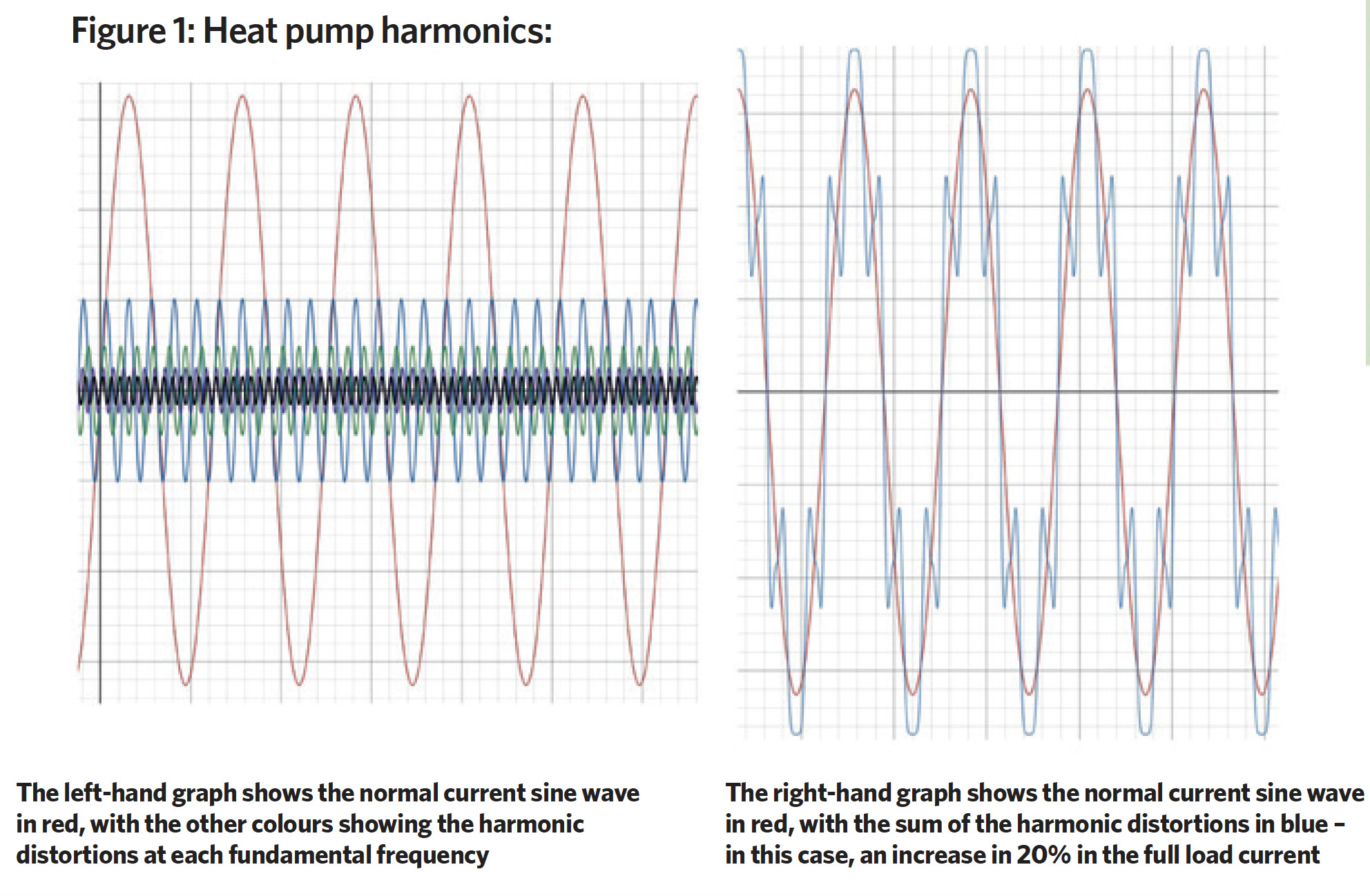
‘It depends on the heat pump model, but the manufacturer gives it as between 30% and 40% total harmonic distortion over the normal sine wave,’ explains Metcalfe. He says it is normal to allow between 5% and 10% to account for harmonics when cable sizing: ‘Anything more than that and you’d expect the manufacturer to have some sort of passive filter in place to limit the impact, but not in this case.’
As a consequence, the associated harmonics resulted in a 20% increase in the full load current. ‘Essentially, if we were to size the cable taking the heat pump data sheet at face value, we’d potentially be undersizing the distribution, because this 20% noise would be adding resistance and heat to our cables, causing them to overheat – I was quite shocked,’ Metcalfe says.
If we were to size the cable taking the heat pump data sheet at face value, we’d potentially be undersizing the distribution
It’s not just the main heat pump for which harmonics are an issue. There would also be an element of noise from each of the dwelling heat pumps, ‘which all add up’, says Metcalfe. The solution, he says, is to keep the problem loads separate from the other loads.
‘We can oversize the electrical distribution for the problem loads to accommodate the noise – but if it the harmonics issues with heat pumps gets worse we would like to investigate using passive filtration,’ he explains.
Charging electric vehicles
The issue of harmonics is also expected to affect the electrical infrastructure for the scheme’s electric vehicle (EV) charging, and Metcalfe has contacted major EV manufacturers for information on harmonics.
‘Electric cars will accept AC from the charger; it’s the cars themselves that transform AC to DC to charge the batteries. So within the car there will be an inverter creating its own level of harmonic distortion that will go back through the charger and on to our distribution,’ he says.
‘I’m only presuming this because I haven’t received information back, but I doubt they are putting passive electrical filters on their cars, so when you many cars plugged in, it will be a cumulative of the harmonics going back to the distribution board.’
BS7671 allows diversity of use to be taken into account to help manage the EV electrical loads and a requirement for load management
Convent Way has 45 EV charge points serving the 117 apartments. This complies with the London Plan’s requirement for 20% active charging and with the new Approved Document S (ADS) of the Building Regulations, which goes beyond the requirements of the London Plan. Because the number of parking spaces is less than the number of dwellings, all parking spaces must have access to an electric vehicle charge point, and the charging points must be 7kW minimum, to comply with ADS.
Rather than size the electrical supply for all 41 points charging simultaneously, Metcalfe says the latest amendment to the wiring regulations, BS7671, allows diversity of use to be taken into account to help manage the EV electrical loads and a requirement for load management.
As the number of charge points is less than the number of dwellings, UK Power Networks gives a diversity factor of 0.8 that can be applied on condition there is some form of load management or shedding.
Managing the EV loads (see panel, right) is important because, when combined with the electrical loads from the dwellings, they give the total electrical load for the scheme. ‘If we had based the loads on the BSRIA Rule of Thumb figure, with load diversity applied to the apartments but not to EV charging, we’d be at a total load of 1.197MVA for the scheme, which is higher than the 1MVA the DNO can accommodate,’ says Metcalfe.
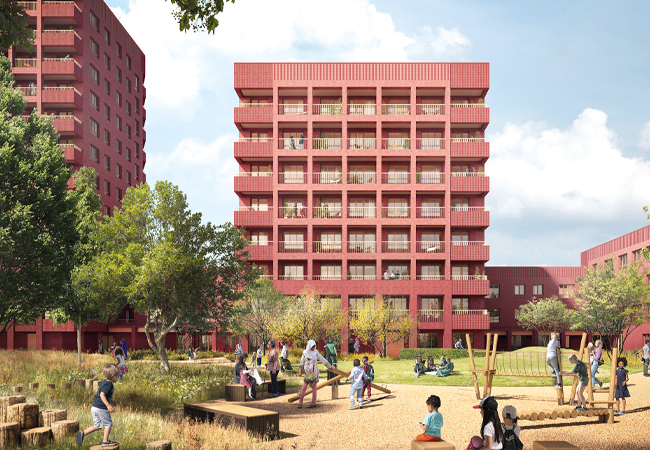
Convent Way will set a new urban dwelling standard for the Borough of Hounslow
However, by building to Passivhaus standards to reduce energy needed for heating, using heat pumps, having more accurate load assessments, and incorporating diversity for EV charging, the estimated total electrical demand figure is now low enough to enable the first phase of the Convent Way regeneration scheme to go ahead.
‘By reducing and managing load where possible and estimating a more realistic consumption of the building we’ve managed a 53% reduction in assumed maximum electrical demand, to 634kVA,’ Metcalfe says. Quite an achievement.
If the EV chargers run at 100% they will have a big impact on the loads, says Metcalfe. ‘We’ve had to look at this in an intelligent way because we don’t know how many residents will have EVs – and of those who do, we don’t know how many vehicles are likely to be charging simultaneously,’ There are two methods of managing the cumulative loads from the EV charge points – dynamic or active – and the scheme is likely to have a combination of the two. In the case of a dynamic load limit, where all the chargers are fed from one distribution board, Metcalfe says the load limit could be set at a pre-determined limit by programming the chargers on a first come first served basis, or by lowering the output to all charge points so all cars will be charged at the same rate. ‘That would be unintelligent load management because it does not take into account what’s happening with the rest of the site,’ he says. Active load management would work in conjunction with the dynamic load limit using a current transformer (CT) clamped onto the live or neutral wire coming into the building. The alternating current flowing in the CT’s winding produces a magnetic field, which induces a current proportional to current being drawn by the Phase A development. ‘If we can understand what power is being drawn by the site, we can control the rate of EV charging accordingly,’ Metcalfe explains. ‘We will still have a preset limit, but at night – when demand drops – there will be a scenario when we could surpass the unintelligent EV limit.’EV load management






